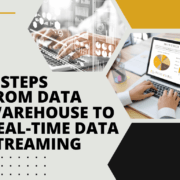The primary purpose of a data warehouse is historical analysis. It is used to manage long-term business processes and evaluate historical data. In the past, the timeliness of data was not very significant. Today, this has changed; for example, real-time data is needed to influence website user behavior directly. Real-time data is also needed in logistics and manufacturing. Only then can managers monitor the status and performance of machines, manage workflows, and improve traffic patterns.
By following these five steps, organizations can move from traditional data warehouse design to real-time data streaming.
1. Identify Traditional Data Warehouse Procedures
First, it should be emphasized that data warehouses are an essential source of business information and have proven to be effective for historical and strategic analysis. Data warehouses often collect data from source systems during off-peak hours to reduce system load and process it in large batches. Such a scenario usually involves initialization. The traditional data warehouse architecture is fine for recursive analytics and ETL tasks; no optimization is required. In this scenario, even standard batch processing tools such as open-source Hadoop solutions can be used to process massive data sets. It is important to understand the limitations of this approach.

2. Suggest Specific Use Cases
Developing process functions for specific use cases is the first step towards a complete real-time process architecture. For example, real-time reports on stock availability can be developed for specific use cases. For example, data on stock availability is sent to the data warehouse at short intervals (about every five minutes or 30 seconds). At the same time, the ETL process continues the standard initialization and nightly batch processing of all other data and reports. The change data capture (CDC) function is also implemented during this part of the ETL process. Pentaho is a possible open-source ETL solution for data integration. This microprocessor-based processing is time or volume-oriented, as opposed to real-time data stream processing. Today, there is a growing need to load more data into the data warehouse faster to accelerate multiple application scenarios.
3. Creating A Scalable Processing Environment
In traditional data warehouse projects, all ETL processes must be fully optimized to enable real-time data processing. Performance-optimized ETL methods are required to ensure that the data source system is not overloaded. The fact that traditional SQL databases are not designed for stream processing means that stream processing needs to be fixed, which is a severe problem with this update architecture. As a result, anomalies occur over time when multiple ETL functions access the same data. A more comprehensive overhaul of the architecture is therefore needed.
4. Continuous Data Processing
The new types of data sources mean that the already complex business requirements for the streaming processing capacity of data warehouses will become even more complex. For example, real-time clickstream data collection from website visitors or Internet of Things (IoT) machine data requires continuous or event-driven processing. The increasing number of ETL traces burdens outbound business systems, especially when multiple traces need to be loaded simultaneously. In traffic-driven scenarios, isolation is no longer possible as before. In addition, the need for synchronization can go beyond simply updating data in the data warehouse. However, vertical extension of ETL paths is not feasible, as managing such a complex infrastructure is impossible. In this case, a more comprehensive solution is needed.

5. Event Stream Architecture
To prepare for future deployments of a data warehouse containing real-time streaming data, it is worth using an event streaming solution such as Kafka. In this architecture, the data warehouse layer is a Kafka cluster instead of the traditional Kafka cluster structure. Data is loaded into the EL process and then transformed using Pentaho or other tools. To do this, the system aggregates the data into streams, with the streams acting as mailboxes to which messages are sent. The user application reads and processes the events registered or entered by the producing application. This way, the producer and the user can be separated in real-time. This simple read-write design effectively increases scalability. Furthermore, the architecture distinguishes between traditional analytical reports and real-time operational reports. In this context, the Confluent platform is a Kafka platform with powerful operational capabilities.
Conclusion
In short, open source is a step in the right direction. After all, event-driven architectures allow organizations to completely eliminate traditional data warehouses‘ limitations in data transfer and real-time data processing. In the approach described above, using open-source solutions is entirely appropriate. The main advantage over closed-source solutions is not cost reduction but increased flexibility and scalability. Open-source software generally offers the best functionality and a wide range of additional features and can be customized to meet specific needs. In addition, open-source software offers greater security, as access to source code is a key security advantage. This means there are no barriers to moving from a traditional data warehouse to a real-time data streaming.


























